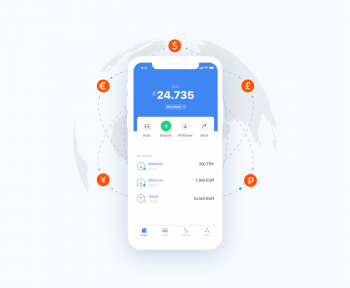The world of today is not borderless. And in such a world, finances can not be limited either. Actually, it is charming what this new financial aspect has brought to our already challenging lives. Previously, sending money abroad was not only pricey but an exhausting process in itself. International money transfers from a traditional bank account could cost you more than 5% of the total amount and the time of transfer could take more than a week.
Today, to send money abroad takes just a blink of an eye and nobody is doomed to either uncertain dates or high fees. Say, if you have a daughter studying abroad, all you need is to use an international money transfer provider and your beloved one will receive it in less than 10 minutes in most of the cases. But is it really rainbows and butterflies? Sadly, no.
“With great power comes great responsibility.” says Voltaire. We have no idea how sending money overseas was done in the 18th century. But the statement holds true. This power of being able to send money overseas comes with security issues. That’s where the importance of keeping yourself educated comes in to the picture. Below, we’ve listed some of the useful tips to pay attention to whenever you need to send money abroad.
How to Avoid Getting Scammed While Sending Money Abroad
Since you will need to insert sensitive information (such as your Social Security number or your banking information), your hard-earned money can be stolen. In a worse scenario, even your whole available balance can be gone. But how to avoid getting scammed while sending money abroad?
- Check the Site URL
No matter whether you are logging into your social media, online banking or e-wallet on any browser, you must check what is written in the address bar. Please note that a secure web address never starts with only “http”, but “https”. Other warnings are an open lock and red background. If you realize one of these, it means the website is neither encrypted nor secure for your personal or financial data.
- Check Fees and Costs
Frankly, transaction fees and costs are unavoidable parts of international money transfers. The ones who promise fee-free services are generally after something hazardous. Plus, charming interest rates that are significantly higher than mid-market’s can also be another red light. Therefore, do not let vain promises fool you.
- Do a Thorough Search
Look for the “About Us” section on the website and search for contact information. Contact information must include at least one current address and a telephone number. Moreover, you can google to find extra information about the subject company.
- Trace Customer Reviews and Complaints
It is impossible not to leave a footprint on the review aggregators for any company. Monitoring mentions of customers, positive or negative reviews or social media accounts, will help you a lot to decide whether they are what they claim to be or not.
- Go Safe
Instead of taking the possibility of risking your financial and personal information, why not choose a prestigious and trustworthy company? Simply register a well-known one like Jeton and operate your transfers smoothly with no apprehension or disbelief.
- Verify the Provider’s Licensing
Always double-check that your money transfer service is fully licensed and regulated by financial authorities. In the U.S., this means being registered with the Financial Crimes Enforcement Network (FinCEN). Regulated entities are more likely to handle your money securely and ethically.
- Use Familiar Payment Methods
Choose trusted payment methods that offer transaction protection, such as credit cards or established online payment platforms. Avoid unfamiliar or irreversible methods like wire transfers or cryptocurrencies, which leave little room for dispute resolution or refund.
- Beware of Urgency Tricks
Scammers often create a false sense of urgency to pressure you into making hasty decisions. Be cautious of any requests demanding immediate action, particularly when it involves sending money. True emergencies should be verified through direct, reliable channels.
- Double-Check Recipient Details
A simple misspelling or an incorrect account number can divert your funds to the wrong recipient, turning a routine transfer into a financial nightmare. Always confirm the recipient’s information thoroughly before finalizing any transaction.
- Keep Software Updated
Protect your digital transactions by ensuring your devices are up-to-date with the latest security software, operating systems, and applications. This reduces the risk of scammers exploiting old vulnerabilities to access your financial data.
- Educate Yourself on Common Scams
Familiarize yourself with prevalent money transfer scams such as overpayment fraud, advance fee schemes, and impersonation scams. An informed sender is a protected sender.
- Secure Your Personal Information
Guard your personal details zealously. Legitimate companies will never ask for your sensitive information like passwords or PINs via insecure platforms. Always question unexpected requests for your personal data.
- Monitor Your Transactions
Keep an eye on your financial statements and regularly check your transaction history. Detecting unusual activity early can prevent further unauthorized transactions and potential financial loss.
Sending Money Abroad with Jeton
Navigating the world of international money transfers can be tricky, with the lurking threat of scams adding an extra layer of concern. Thankfully, Jeton offers a reassuring solution that simplifies the process and enhances security. With Jeton, you can confidently send money abroad, knowing that your transactions are safeguarded against the risks that often accompany financial transfers across borders.
Jeton’s blend of user-friendly technology and stringent security measures makes it a beacon of reliability in the often uncertain terrain of international payments.So, relax and let Jeton take the stress out of your global financial transactions, ensuring your money is safe and sound, no matter the distance it travels.
Stay Informed While Sending Money Abroad
By adding these detailed tips to your guide whenever you need to send money abroad online, you can navigate the complexities of international money transfers with confidence and caution.
Remember, the digital world is vast and often tricky to wander around in. By arming yourself with knowledge and using trusted services, you transform into a savy sender who not only knows the ropes but can also avoid the snares. Stay alert, stay informed when sending money abroad!




